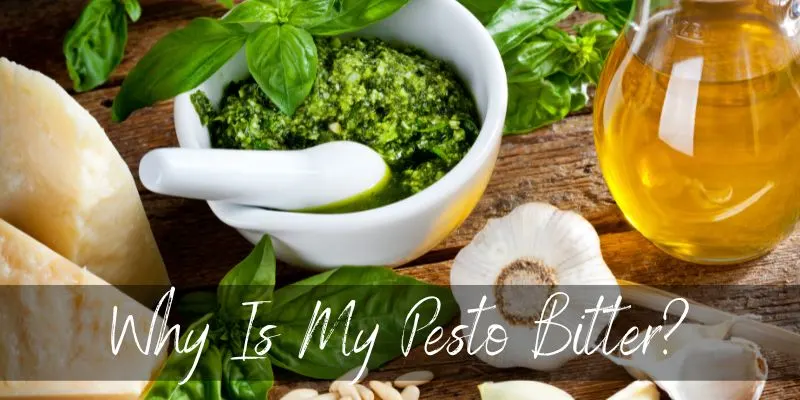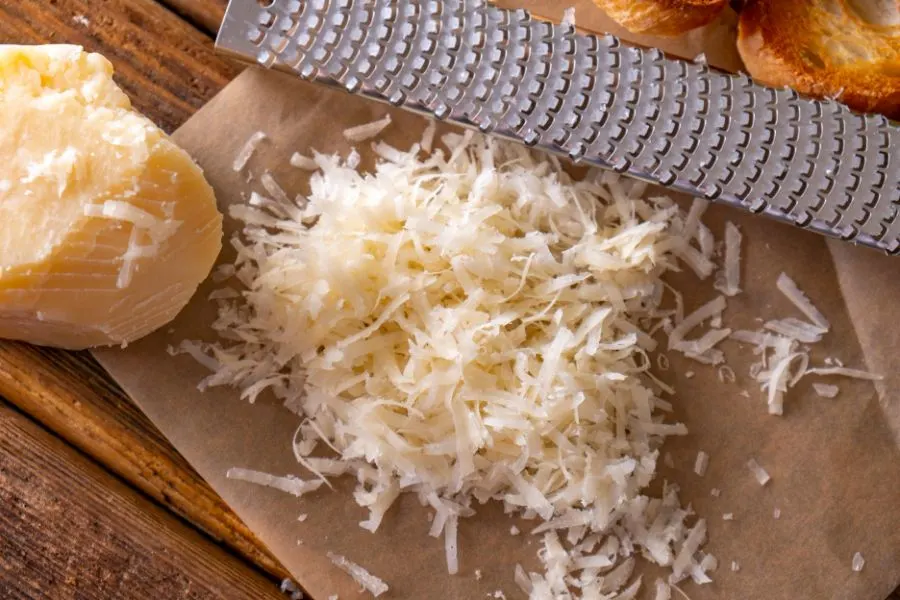We have an entire article about why basil can taste bitter, but why pesto tastes bitter is different since there are more ingredients to it, not only pesto.
Yea, the basil having a bitter taste can be one of the reasons for it, but it is not the most common reason for the bitter taste in pesto.
In this article, we will talk about all the possible reasons for the unpleasant bitter-tasting pesto and how to get rid of the bitterness. Also, how to know if it is still safe to eat pesto that has a bitter taste.

Why is my pesto bitter?
The main reason for pesto’s bitter taste is that it was overprocessed in the food processor, leading to breaking basil down. As we discussed in the article about why basil is bitter: chewing, breaking, or cutting basil can make it taste bitter because it will release an enzyme that has a bitter taste.
Also, too much agitating the olive oil can make it taste bitter. You should not use the food processor for more than 2 minutes, and you should add the ingredients one at a time, not all of them together, and mix for 2 minutes.
I will not get into more details about how to make pesto at home since that will be an entire article, but here is an awesome recipe for homemade pesto that will help you.
Is it safe to eat bitter pesto?
Bitter-tasting pesto is still edible if the reason for its bitter taste is that it was overprocessed. If somehow it is bitter because it is going bad, you should discard it immediately.
So, most of the time, you can go ahead and eat or fix bitter pesto if you check to make sure it has not gone bad. We will talk later in this article about what you should look for to know if pesto has gone bad.
Tips to fix bitter pesto
While it is safe to eat bitter pesto, you would most probably not enjoy it that way, so those next tips should help you get rid of the bitter taste of pesto.
Before going to the tips on how to fix bitter pesto, it is important to let you know how to prevent the bitter taste. See, prevention is the key.
Ensure you wash the basil thoroughly before using it, and check the taste of the olive oil and pine nuts before adding them to the mix.
Also, chopping all the ingredients by hand before adding them to the food processor will help a lot since you will have to use the food processor for less time and only to mix the ingredients, not to chop them.
Now let’s talk about the tips to fix bitter-tasting pesto.
-Add more finely grated cheese. By adding more pecorino romano or parmesan cheese, you will make the pesto taste more cheesy, but it will cover the bitter taste quite well.

-Add lemon juice. While this is a good way to get rid of the bitterness from pesto, it will make it a bit more acidic and sour, so you should be fine with that.
-Add more nuts. Adding more nuts to the mix will make it crunchier, and the taste will not be as sharp, but this can be a great solution to fixing the bitter taste of pesto. Make sure you check the taste of the nuts before adding them to the mix not to add more bitterness by mistake since the nuts can also taste bitter.
-Add more salt. Adding more salt is an effective way of getting rid of the bitter taste of pesto and also works in getting rid of the bitterness from some vegetables like kale, cabbage, broccoli rabe, and more.
What you should not do in order to get rid of the bitter taste of the pesto is to add sugar or honey. While this may work sometimes, the problem is that no one wants a sweet-tasting pesto.
Also, adding more oil is not a solution since it will not eliminate the bitterness, and your pesto will be too wet and oily.
How to check if pesto has gone bad
Before trying to fix bitter-tasting pesto, you should check if it hasn’t gone bad. If you have a store-bought pesto or you’ve made it yourself but a while ago, the bitter taste from pesto can be due to the pesto going bad.
So here are a few things to check before trying to fix or eat bitter pesto:
-Mold. If you see any sign of mold on your pesto, you should not eat it anymore or try to fix it. Even if the mold is only on top of the pesto, there are high chances that the bacteria has infiltrated inside the pesto as well.
-Color. If you notice a change in color from green to yellow or brown, that signifies that the pesto has gone bad or is going bad soon. Either way, it will not be a pleasure eating it.
-Smell. The smell is usually an obvious sign if the pesto has gone bad. It will no longer smell fresh and grassy but rather rotten, sour, and off-putting.
If you noticed any of the signs above, you should not try to fix the bitter taste of pesto but rather get rid of it immediately.
Read Also: Why Is My Ginger Bitter?
Conclusion
Pesto is pretty sensitive to overprocessing, so you should make sure you do not overprocess it; otherwise, the bitter taste will be present.
As discussed in this article, there are a few good ways to prevent the bitter taste and several ways to get rid of the bitterness if it appears anyway. The downside to fixing the bitter taste of pesto is that many methods will change the taste and texture of the original pesto recipe you went for in the first place.
I hope this article helped you know what to do with bitter taste pesto and how to check if you should fix it or not.

